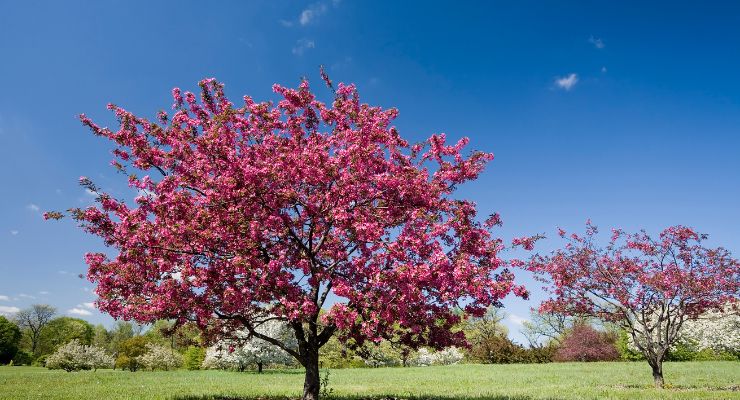Pink flowering trees are a beautiful and popular choice for adding color and beauty to landscapes and gardens. These trees are known for their spectacular displays of pink blooms, which can range from pale shades to deep, vibrant hues. Pink flowering trees come in a variety of shapes and sizes, from small ornamental trees to large shade trees.
Some popular types of beautiful pink flowering trees include the cherry blossom tree, magnolia tree, dogwood tree, redbud tree, and crabapple tree. Each of these has its own unique characteristics, including bloom time, flower shape, and growth habits.
In addition to their beauty, pink flowering trees can also have practical benefits. They can provide shade, attract pollinators, and improve air quality. With their striking blooms and many benefits, pink flowering trees are a popular choice for homeowners, landscapers, and garden enthusiasts alike.
Crabapple Tree (Malus Pink Princess)
The Pink Princess Crabapple, also known as Malus ‘Pink Princess’, is a crabapple tree that can be grown as a short tree or a broad-spreading, horizontally-branched, slightly pendulous, multi-stemmed shrub.
Its purple foliage transitions to bronze-green in the summer, and it blooms with rose, and pink flowers in the spring. It is a low-spreading flowering tree and a dwarf version of the Sargent Crabapple, known for its elegant rose-pink flowers.
To ensure proper care for a Pink Princess Crabapple tree, it is recommended to plant it in medium moisture, well-drained, acidic loams in full sun. The tree can adapt to a variety of soils and has some drought tolerance once established. Pruning should take place during the later winter or early spring season when the plant is dormant to minimize the risk of pruning and stimulating new growth at the wrong time of year.
When planting the tree, it’s essential to gently loosen the root ball and incorporate soil amendments such as peat moss and coffee grounds to help maintain soil health.
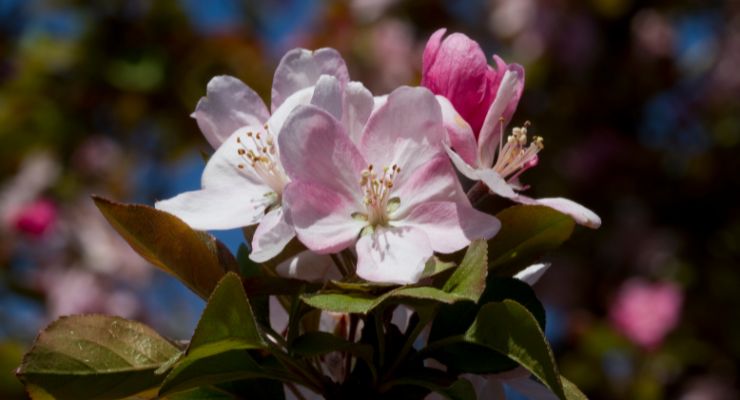
Orchid tree (Bauhinia Variegata)
The Orchid Tree, also known as Bauhinia variegata, is a small semi-evergreen to deciduous shrub or tree with a spreading canopy of light. The tree’s orbiculate leaves are bi-lobed and emarginated, and its arching branches are adorned with large pink flowers that resemble orchids. The tree blooms profusely from late winter to early spring and can reach heights of 20-40 feet with a 25-35 foot spread, making it fast-growing.
To care for the Orchid Tree, it’s recommended to water it occasionally, making sure to apply water slowly so that it penetrates deep into the soil. During the hottest summer months, watering should be increased to every 10 days.
The tree may drop its leaves during dry winters, but they typically return in late winter or early spring. Fertilization should take place in winter with compost or manure and with mineral fertilizer rich in potassium during flowering. Pruning should be done lightly after flowering and again in the late season.
The Orchid Tree prefers full sun to light shade and can be easily grown in moist, well-drained soils. It should be protected from cold winds and is drought tolerant once established.
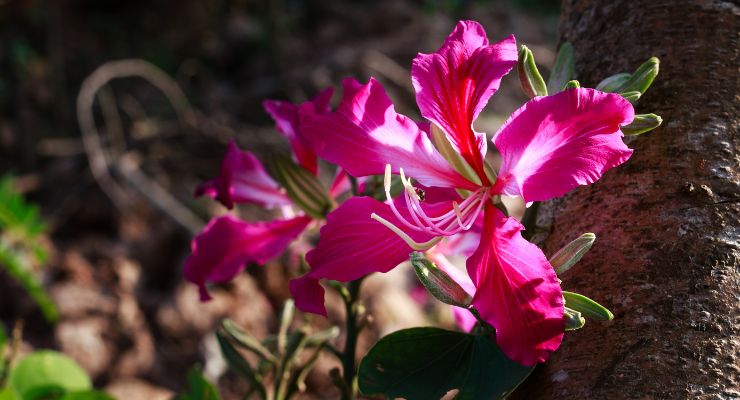
Flowering Almond Tree (Prunus Triloba ‘Multiplex’)
The flowering almond tree, also known as Prunus triloba ‘Multiplex’, is a dense, rounded, deciduous, multi-stemmed shrub that can grow up to 10-15 feet tall and wide, and is sometimes grown as a small tree. Its beautiful double pink flowers bloom in mid-spring, while the leaves are medium green in color and alternate, simple, obovate to broad-elliptic in shape.
To care for the flowering almond tree, it’s best to grow it in moist, fertile, well-drained loams in full sun to part shade. Regular pruning is necessary to remove dead wood and maintain the tree’s shape. Consistent watering throughout the spring and summer is also essential, and a slow trickle of water (soaker hose) is recommended to evenly saturate the soil around the tree.
It is susceptible to numerous insect and disease problems, including leaf spots, dieback, powdery mildew, cankers, and black knot. Aphids, scales, borers, caterpillars, and spider mites are among the potential insects that can harm the tree. Spider mites, in particular, can cause stippling, yellowing, and premature leaf drop by sucking juices from inside the leaves of flowering almond trees.
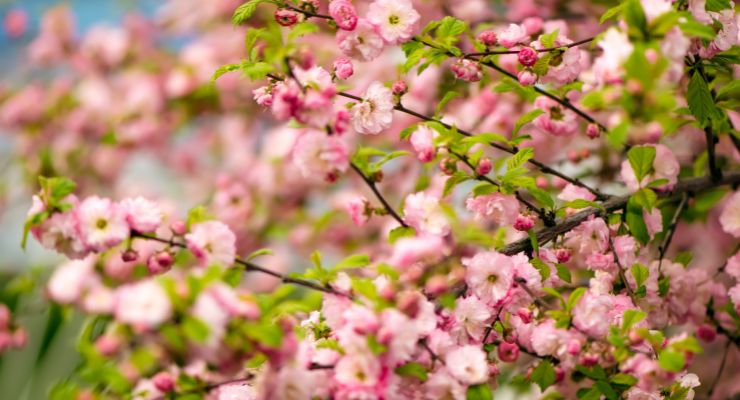
Kwanzan Cherry (Prunus Serrulata ‘Kwanzan’)
The Kwanzan Cherry, scientifically known as Prunus serrulata ‘Kwanzan’, is a stunning cultivar of double-flowering cherry trees, featuring beautiful pink blossoms that make it the most popular of its kind. This small deciduous tree grows up to 36 feet in a vase-like shape with serrated leaves that can reach up to 4-5 inches in length, emerging reddish in color.
The Kwanzan Cherry thrives in full sun and requires well-drained, moist, loamy soils enriched with humus. It is intolerant of poor drainage. Planting is best done during the spring or fall, depending on frost conditions.
To complement the beauty of the Kwanzan Cherry, Buxus is a great companion plant. Lavender, rosemary, marigolds, and dandelions are also commonly planted alongside cherry trees to provide support and balance.
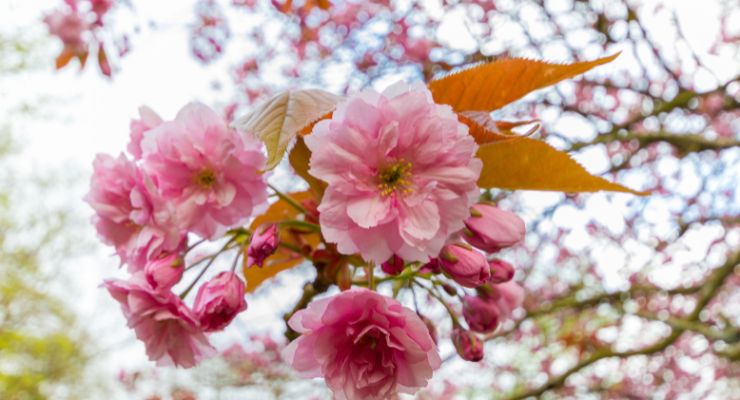
Pink Trumpet Tree (Tabebuia Heterophylla)
The Pink Trumpet Tree, or Tabebuia heterophylla, is a stunning tree with pink or white bell-shaped blooms that appear in the spring and summer, followed by slender seedpods. This winter-deciduous tree has a moderate growth rate and an upright, open, low-branching habit, with dark green foliage.
To care for Trumpet Tree, it should be planted in full sun or partial shade on reasonably fertile soil that can drain, preferably slightly acidic loam. The tree is somewhat tolerant of salts in the soil and highly drought-tolerant, but young seedlings and plants require frequent, deep watering, especially during the first few months of growth.
After the first year, young trees need watering about once a week during the growing season unless there is adequate rainfall. The tree should be protected from frost.
It is recommended to underplant companion plants that can tolerate the sun in winter and shade in summer, such as variegated arboricola, pentas, and dwarf podocarpus. It is important to note that all parts of the tree, including the bark, flowers, and leaves, are considered toxic to dogs if ingested.
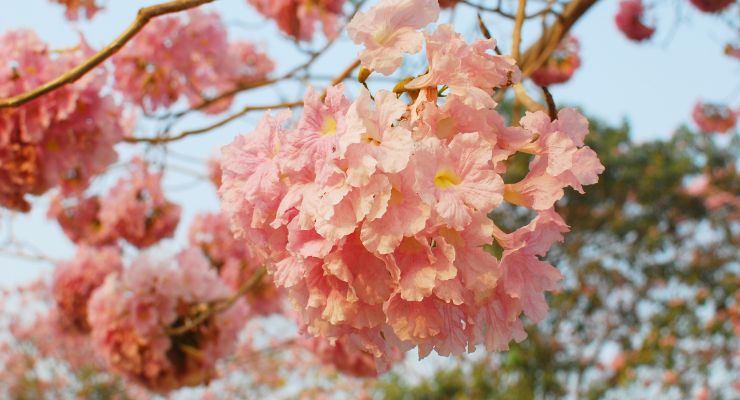
Royal Poinciana Tree (Delonix Regia)
The Royal Poinciana, also called the Delonix regia, flamboyant, or phoenix flower is a tropical tree that is native to Madagascar but has become popular in tropical and semi-tropical regions worldwide. Its broad-spreading, umbrella-like crown can reach 30-40 feet tall, and it is renowned for its brilliant red-orange blooms that blanket the tree tops.
For optimal growth, plant the Royal Poinciana in a location that receives full sun, and avoid frost-prone areas (generally USDA hardiness zones 9b–11). The tree can thrive in a variety of soil conditions and once established, it can tolerate both drought and salt.
There are no major pest or disease issues. After planting, water the tree regularly during the spring, summer, and early fall, keeping the soil moist but not waterlogged until the roots take hold.
Dig a hole that is two to four times as wide as the root ball, gently spread out the roots, and back-fill the hole until the roots are covered. To propagate using seeds, soak them in warm water for about 24 hours before planting in regular potting soil with added coarse sand for good drainage.
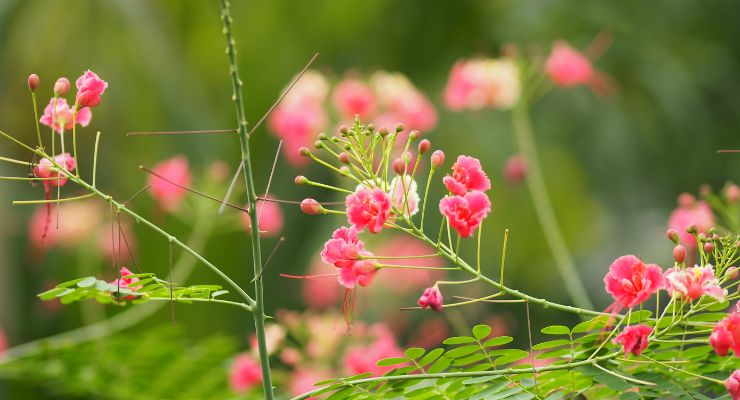
Jane Magnolia (Magnolia ‘Jane’)
The Magnolia ‘Jane’ is a compact, upright, slow-growing deciduous tree with a multi-stemmed habit that can reach a height of 20-25 feet and a spread of 15-20 feet. Its striking, large reddish-purple flowers with white centers resembling tulips cover the bare branches before the leaves emerge in late spring, making it a stunning addition to any landscape. The tree can be trained as a shrub or small tree.
To ensure optimal growth of the Magnolia ‘Jane,’ it should be planted in full sun to partial shade in moist, rich, well-drained soils that are neutral to acidic. Regular mulching of the root zone will help keep the soil moist.
This tree is also tolerant of heavy clay soils, air pollution, and heat. Planting a Jane Magnolia tree involves digging a hole as deep as the root ball and three times as wide, mixing the removed soil with compost or peat moss to enrich it, and backfilling around the roots. During the first summer season, water the newly planted tree deeply two to three times per week.
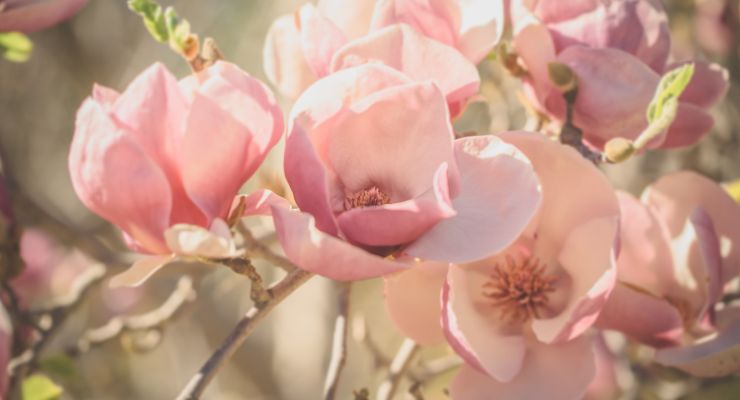
Pink Flowering Dogwood (Cornus Florida ‘Rubra’)
The Pink Flowering Dogwood, or Cornus florida ‘rubra’, is a charming deciduous tree that typically grows to 15-30 feet in height with a low-branching habit. In mid-spring, it produces clusters of stunning pink flowers with pink bracts that bloom atop the branches. Its oval leaves measure 2-5 inches long and turn into a beautiful red-purple hue in the fall.
To cultivate this tree, plant it in an area that receives partial shade with fertile, well-draining, and evenly moist soil that is either acidic or neutral. While it can tolerate full sun, it tends to be denser in these conditions. The roots of the Pink Flowering Dogwood should be kept cool with mulch during the summer and provided with shelter in exposed locations.
It is important to note that Jane Magnolias are vulnerable to diseases resulting from both bacteria and fungi. While the leaves may be damaged by leaf spots, the shoots, twigs, or branches can be affected by cankers.
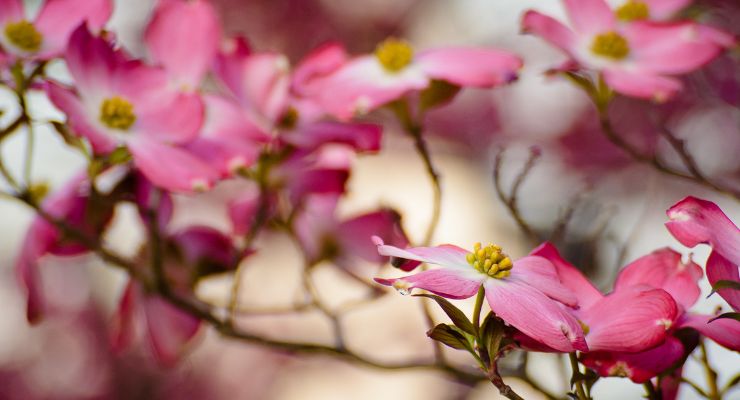
Red Horse Chestnut (Aesculus × Carnea)
The Red Horsechestnut tree has a medium-sized, rounded to broad-rounded habit and is famous for its magnificent floral display. It produces cone-shaped rose, red, and pink flowers that bloom in late spring, making it an excellent shade tree for large areas.
To care for a Red Horse Chestnut tree, plant it in a location that receives full sun-to-light shade. The tree prefers consistently moist soils with excellent drainage to prevent root rot. Acidic soils promote the tree’s health.
When young, the tree should be well-watered, and older trees are drought-tolerant. Create a mulch ring around the tree in lawns to keep the soil evenly moist and reduce competition from grass. In full sun, the trunk is prone to cracking.
The Red Horse Chestnut initially has a pyramidal shape but matures into a dense rounded form after 5 to 7 years. Prune the tree in early spring before the sap starts to flow or in fall after the leaves have dropped.
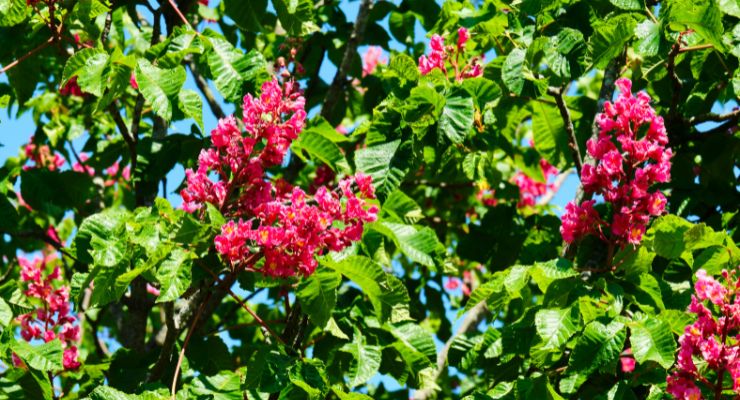
Eastern Redbud (Cercis Canadensis)
The Eastern Redbud, scientifically named Cercis canadensis, is a small deciduous tree with gracefully ascending branches and a rounded shape that usually reaches a height of 20 feet with a similar spread.
The leaves are alternate, simple, and broadly heart-shaped, measuring 3 to 5 inches high and wide, emerging reddish and turning green as they expand. The tree has one to several maroon-purple picturesque trunks and a wide umbrella-like crown, and its pink flowers are borne in tight clusters. It is widely used as an ornamental in gardens and landscaping in zones 4 to 9.
The Eastern Redbud can grow in full sun to partial shade, although it blooms best in full sun. It can tolerate clay soil, but it grows best in moist, well-drained deep soil. Place approximately 3 inches of mulch around the tree, but ensure it is not touching the trunk to help retain moisture and suppress weeds.
The Eastern Redbud typically needs watering about once a week when the soil is dry at a depth of 2 to 3 inches. Plant the tree in a location protected from northern and western cold winter winds, particularly if it is growing in zone 4. Prune the tree after flowering in spring to remove dead or damaged wood.
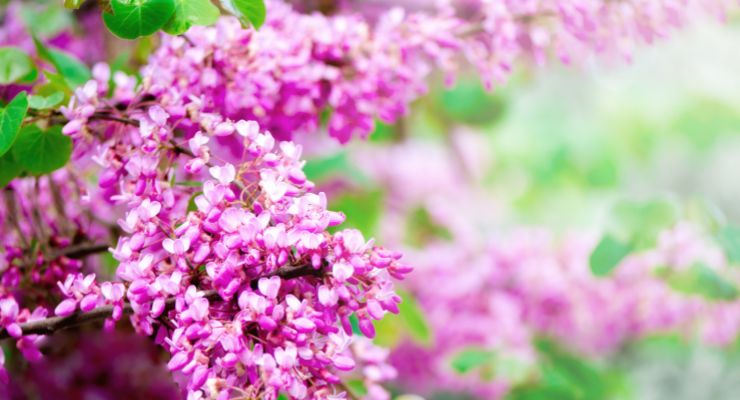
Crape Myrtle (Lagerstroemia Spp)
The Crape Myrtle, or Lagerstroemia spp., is a deciduous tree that typically grows to a height of 10 to 20 feet. The name “crape myrtle” comes from the crepe-like texture of the beautiful flowers, as well as the bark and leaves which resemble those of the myrtle plant.
In the summer, the tree produces an abundance of pink blooms that can last well into the autumn. Its dark green leaves emerge in the spring.
To care for this pink flowering tree, it should be watered deeply and regularly during the first few years of growth, but once established, it can tolerate drought.
When it comes to pruning, it’s best to limit it and avoid removing too many growing branches as this can result in the growth of suckers. Crape myrtles should be pruned in late winter or early spring, as they bloom on new growth. Dwarf and short varieties may only require minor cosmetic pruning.
I’ve already been writing about the Acoma Crape Myrtle Tree (Lagerstroemia indica), which has similar characteristics if you’d be interested in a white flowering version of this tree.
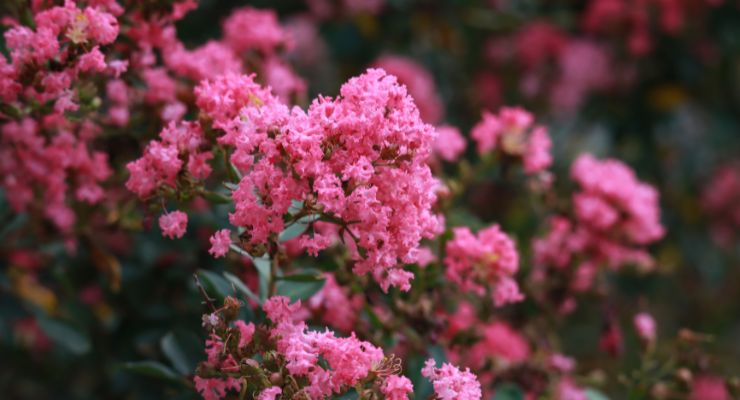
Japanese Flowering Apricot (Prunus Mume)
The Prunus mume, also called the Japanese flowering apricot, is a resilient tree that is highly resistant to insect pests and diseases. It is hardy to USDA zone 6 and may be the longest-living among the flowering fruit trees.
Its picturesque and gnarled form can reach a height of 20 feet, and in winter, it blooms on bare branches with numerous small pink flowers that emit a delightful fragrance, adding to the tree’s distinctive character. The five petals of the flower symbolize longevity, wealth, health, virtue, and natural death.
To cultivate a Japanese flowering apricot, plant it in full sun to partial shade in moist, acidic, loamy soils. It is best to plant the tree in protected areas to prevent winter cold from damaging the pink flowers and fruits.
Pruning should be carried out after flowering by cutting half of the long shoots back by one-half to two-thirds to promote old and new wood growth each year. For optimal flowering, the tree requires heavy pruning. It is recommended to water deeply once a week rather than frequently for a few minutes, maintaining even soil moisture.
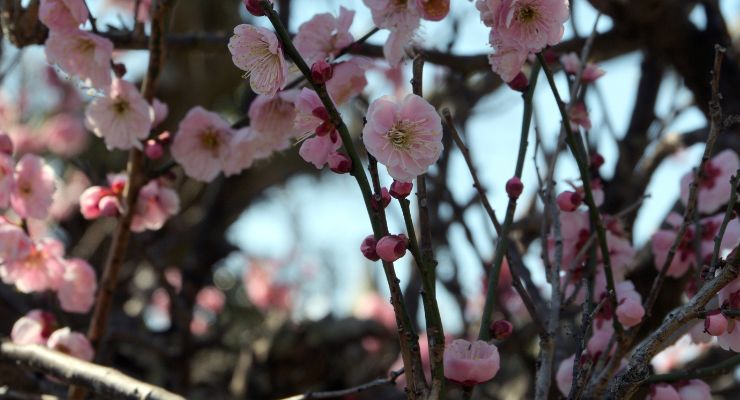
Conclusion of the Pink Flowering Trees
In conclusion, pink flowering trees are not only visually appealing, but they also bring a multitude of benefits to landscaping. Their vibrant colors and striking blooms can enhance the beauty and charm of any outdoor space. These trees are available in a wide range of sizes, shapes, and varieties, allowing them to fit into any landscaping design.
Trees with pink flowers also offer environmental benefits, including providing shade and habitat for wildlife, reducing erosion, improving air quality, and absorbing carbon dioxide from the atmosphere. Furthermore, they can also increase the property value of a home or commercial property, making them a worthwhile investment.
However, it is essential to select the right trees for the right location and purpose. This includes considering factors such as soil type, moisture levels, sunlight exposure, and climate. Proper maintenance, including pruning and watering, is also crucial for ensuring the health and longevity of pink flowering trees.
Additionally, pink flowering trees can have compound benefits when paired with companion plants. For example, planting pink flowering cherry trees with daffodils can create a stunning spring display. Selecting the right trees for the right location and purpose is important to ensure that they thrive and provide the desired benefits.
In summary, incorporating pink flowering trees into landscaping can bring a plethora of benefits and contribute to creating an aesthetically pleasing outdoor environment. By carefully selecting the appropriate trees for the location and maintaining them properly, homeowners and landscapers can enjoy their beauty and advantages for years to come.
